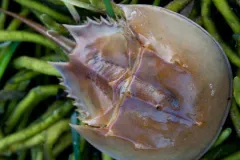This Flu Season, Thank a Horseshoe Crab

Fever. Aching muscles. Coughing. Sniffling. It’s flu season. Have you had your shot? If so, thank a horseshoe crab.
In fact, if you’ve been put on an IV, had a medical device implanted, or received nearly any injectable medication or vaccine in the past few decades, you likely owe the humble horseshoe crab a debt of gratitude. These bizarre creatures—with their helmet-shaped shells, blue-colored blood, seven pairs of legs, and 10 eyes—hold an important medical tool in their bloodstreams.
In the 1950s, researchers noticed that the blood of the western Atlantic horseshoe crab species (called Limulus polyphemus by scientists) clots vigorously when exposed to certain bacteria. With further study, scientists at the Marine Biological Laboratory in Woods Hole, Mass., determined that a compound called LAL (short for Limulus Amebocyte Lysate) is responsible for the clotting. LAL acts as a safeguard for the animals, reacting when it comes into contact with bacteria, fungi, and—perhaps most importantly—proteins called endotoxins that are part of the cell structure of certain bacteria.
If they get into a person’s bloodstream, endotoxins can cause a range of problems from fever to burst blood vessels in the brain. Even after an item has been sterilized of live bacteria, endotoxins can be left behind. Researchers quickly saw the potential to use LAL as a simple, reliable test for endotoxins and developed methods to extract the compound.
Today, LAL is widely used to test for contamination of medical equipment and injectable medicines—like flu shots.
A few companies on the East Coast of the U.S. even specialize in producing large quantities of LAL for medical use. For the most part, the compound can be extracted without seriously harming the animals, and most (studies estimate 85 percent or more) recover from the procedure soon after they are returned to the water.
But horseshoe crabs—and the species that depend on them—do face serious threats. Their populations are in decline, and the choices we make could determine whether these “living fossils” that have been around for millions of years continue to thrive. Habitat destruction that accompanies coastal development presents a danger, both to Limulus populations and to their relatives in Japan. Horseshoe crabs are also harvested for use as bait in eel and whelk fisheries. And recent research suggests that climate change is a growing concern.
In some locations, citizens can get involved in research and conservation efforts to help horseshoe crabs. Project Limulus relies on volunteers to help tag horseshoe crabs in Connecticut and New York, and every year population surveys are conducted with help from volunteers all along the east coast of the U.S.

